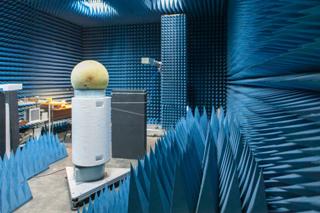Apr 15 2015
A team of physicists from ITMO University, Australian National University and Ioffe Institute have successfully created homogenous cylindrical objects which are totally invisible in the microwave range.
 This is the radio-frequency anechoic chamber used for the experiment. (Credit: ITMO University)
This is the radio-frequency anechoic chamber used for the experiment. (Credit: ITMO University)
The process they used was based upon a new perception of electromagnetic wave scattering. Essentially, the notion of invisibility was thought to depend on metamaterial coatings; however, for the first time no additional coatings were used on the homogenous object.
The physicists observed the process of light scattering using a glass cylinder filled with water. This experiment symbolizes a 2D analog of a typical scattering problem from a homogeneous sphere referred to as Mie scattering, and the solution has been in existence for nearly a hundred years. This conventional problem is based on unusual physics and occurs in materials with high refractive indexes. For the research, the team chose to use ordinary water as its refractive index can be controlled by altering the temperature.
The result revealed that high refractive index is linked to two scattering mechanisms - resonant scattering and non-resonant scattering. The first type is connected to light localization within the cylinder while the second type is signified by continuous dependence on wave frequency. Fano resonances can be referred to as the interaction between these mechanisms. The physicists realized that the object is rendered invisible due to the fact that, at specific frequencies, scattering of waves occurred through resonant and non-resonant mechanisms, which have opposing phases and cancel mutually.
Through this research work, for the first time an invisible homogeneous object has been observed using scattering cancellation. The key finding was the possibility of switching from visibility to invisibility regions at the same 1.9GHz frequency by merely altering the water temperature in the cylinder from 90°C to 50°C.
Our theoretical calculations were successfully tested in microwave experiments. What matters is that the invisibility idea we implemented in our work can be applied to other electromagnetic wave ranges, including to the visible range. Materials with corresponding refractive index are either long known or can be developed at will.
Mikhail Rybin
Senior researcher at the Metamaterials Laboratory in ITMO University
From an engineering standpoint, this research finding of invisibility occurrence in a homogenous object rather than in a coated object is highly significant, especially because it is much simpler to create a homogeneous cylinder. This finding will enable advancements in the development of nano-antennas, in which invisible structural elements may possibly assist in decreasing disturbances. One of the applications is the use of invisible rods to hold up a miniature antenna complex linking two optical chips.
The development of metamaterials brought the topic of invisibility to the forefront. Metamaterials are artificially designed structures consisting of optical properties not found anywhere in nature. Metamaterials possess the ability to alter the direction of light in unusual ways such as curving light around a cloaked object. However, it is very difficult to coat layers on metamaterials and these formations do not match with several other invisibility concepts.
Therefore the technique formulated by the team is founded on a deeper insight into scattering processes surpassing existing techniques in cost-effectiveness and simplicity.
The research findings have been published in Scientific Reports.